CUNY’s James Gallery at The Center for the Humanities ushers in the fall semester with an exhibition based on Alison Knowles’s 1967 conceptual work The House of Dust. The show seeks to encompass the many limbed and generative nature of Knowles’s artwork by showing how it continues to stimulate other artists to explore its themes of translation, permutation, intentionality and inclusivity, bringing to light the work’s enduring relevance.
The House of Dust is a computer generated poem written in the programming language FORTRAN, which generates verses by randomly combining elements from four lists pre-determined by Knowles: each verse consists of four components including, and always beginning with, “a house of,” followed by a location, then a material, and finally a category of inhabitants. The poem repeats after 400 verses. In 1969, based on one of the verses, “A HOUSE OF PLASTIC/ IN A METROPOLIS/ USING NATURAL LIGHT/ INHABITED BY PEOPLE FROM ALL WALKS OF LIFE” Knowles constructed an actual “house” in Chelsea. The house was moved to Burbank, California when she took a teaching position at CalArts in 1970. Knowles also orchestrated several other projects using computer programs, involving students and community members with her house as the nexus.
Upon entering the exhibition, the visitor first confronts the instantiations of Knowles’s The House of Dust, and is asked to consider within the inherent confinement of a gallery space a work that was never meant for traditional exhibition. As per the checklist, the gallery is divided into three spaces, each representing a different “house,” or verse from the poem. Inside this introductory “house,” named after the foundational House of Plastic, the visitor is prevented from seeing directly into the rest of the gallery by the placement of several temporary walls. A printer on a pedestal in the center of this introductory space prints Knowles’s FORTRAN poem onto continuous stationery which then cascades down behind the pedestal and settles accordion style onto the floor. Its familiar mechanical chatter creates an auditory background to the whole exhibition. This “house” presents images of Knowles’s architectural structure, a vitrine of archival materials, and a wall presentation of “gift objects” collected from the artistic community which were intended to be adhered to the surface of the structure after an unrealized move to Minneapolis.
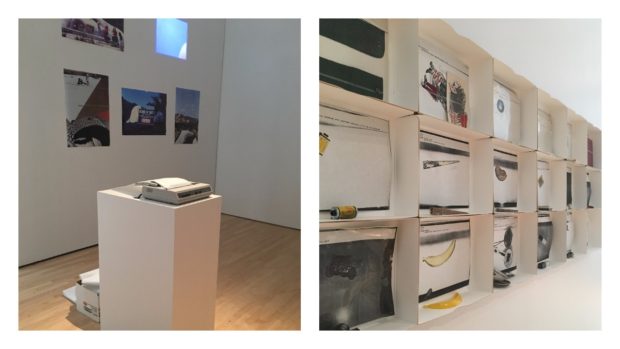
This section of the gallery gives the visitor a sense of Knowles’s motivations and the character of her project. At its core, The House of Dust sought to dismantle the computer generated systems that began to impose themselves on society in the 1950’s. Knowles translated computer programming language into written language (poetry) which she then translated again into architectural form. In this project, physical architecture represents the antithesis of the intangible virtual framework of an algorithmic logical system. Although both, in a sense, contain human presence, within Knowles’s architectural structure is implicated the physical presence of the human body, which in its blatant materiality cannot be computerized. The James Gallery has taken on a difficult task: corrall the many crisscrossing narratives of The House of Dust into a coherent exhibit, conceptually available even to the casual passerby. The gallery approaches this task by dedicating most of its space to the work of contemporary artists who have responded to or reframed Knowles’s poem.
Moving further into the gallery, the visitor is introduced to “The House of Stone,” an array of contemporary art that responds to Knowles’s work. The synthesized voice of Katarzyna Krakowiak’s sound work Oh no, please don’t mingles with the chatter of the printer and creates a sensory bridge between the first and second sections. Work in “The House of Stone” loosely explores translation between language and architecture. Knowles used architecture to highlight the difference between physical and simulated inhabitation or presence, and the artists in the show reframe this aspect of The House of Dust to explore themes of inclusion, exclusion, and displacement. Keren Benbenisty, for example, has rendered in CAPTCHA sentences from the Tower of Babel in Genesis and projected them in a darkened and curtained off section of the gallery. More socially focused examples, Alan Michelson’s Cherokee Phoenix Printshop and Home in the Wilderness, combine familiar architectural forms with written language to force the viewer to contemplate the displacement of the Cherokee people. A vitrine in this section further emphasizes connections between The House of Dust and architecture by representing conceptual artists who, like Knowles, have tried to divorce architecture from its emphasis on practicality and permanence. In this section, works are also presented that primarily explore serial progression, directive score, and the readymade. On the right hand wall unfolds Nicholas Knight’s Taxonome IV painting, for which he designed an algorithm to guide its creation. He adopted Knowles’s categories of location, material, and inhabitants, effectively removing aesthetic choice from his process.

The final section of the exhibition is titled “The House of Paper.” This section highlights the conceptual aspect of Knowles’s work that addresses the relationship between the visual and the verbal. The House of Dust places itself in the conflictual division between art and language. Knowles has aligned herself with other artists who explore artistic intention, and their art has a particularly slippery relationship with language; even an object that resists artistic intention is necessarily subjected to human choice as soon as it is described verbally and its conceptual breadth is limited to the relative rigidity of vocabulary. The James Gallery conveys this subtle yet crucial aspect of Knowles’s projects through the work of other artists who explore translation, not only between the visual and verbal but between the visual and auditory, or the visual and tactile. This section prominently features Nina Safainia’s interpretation of the quatrain: A HOUSE OF PAPER/ ON AN ISLAND/ USING ALL AVAILABLE LIGHTENINGS/INHABITED BY PEOPLE SPEAKING MANY LANGUAGES WEARING LITTLE OR NO CLOTHING. The visitor is invited to walk into its low walled structure constructed of stacks of today’s newspapers and two Graduate Center publications based on the exhibition. Visitors are encouraged to take copies of these CUNY publications. Within and around this structure are other works by Knowles from the 60s into the 00s, which help contextualize The House of Dust within her oeuvre.
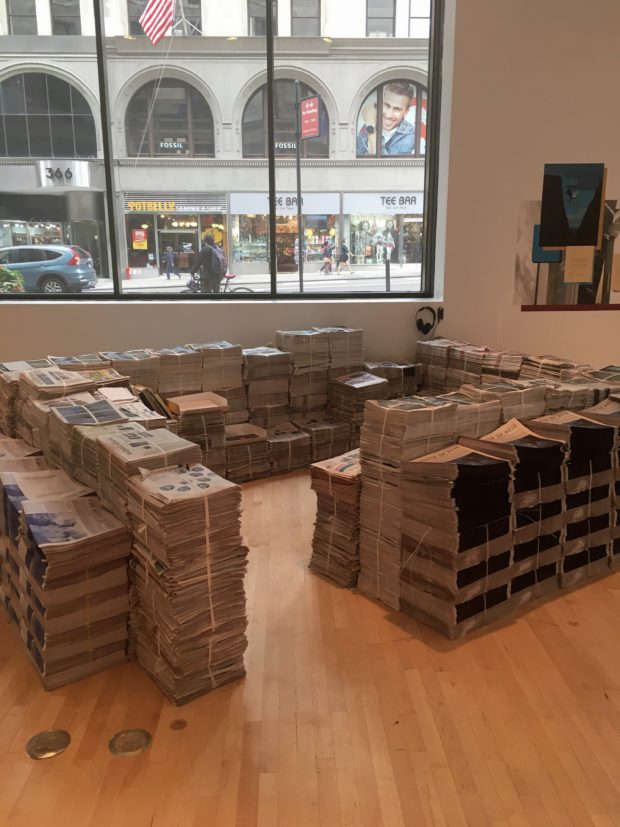
In Knowles’s work, the human vocabulary is mimicked by a computer to create a score, which is then translated into a physical architecture that reaffirms and celebrates human presence and generative ability. Since the built “house” reflects just one verse, one randomly generated set of conditions, it stands in for all the theoretical structures that could rise from these permutations. The James Gallery takes this generative potential a step further, renewing the conceptual relevance of Knowles’s work through its reinterpretations by contemporary artists. Knowles’s manifesto against a computerized society was in a sense triumphant. The computer program is rigid, the score it creates prescribed, but Knowles met this reductivity with subjective interpretation, physical response, and community collaboration. Today’s viewer wonders, however, at how much more complex the algorithmic directives have become since the work’s inception in 1967. These programs contain human presence so completely that we struggle to extricate ourselves. How separate, for example, are our identities on Facebook from the ones we present physically? For the sake of building a database, Facebook enforces a specific approach to self representation and the way people relate to one another, becoming so universal that it occludes other possibilities. Knowles’s work is premonitory; perhaps she recognized the early stages of what we are now unable to disentangle or even perceive clearly, as computers direct our lives in ways even beyond our consciousness.
Editor’s Note: The House of Dust at The James Gallery at CUNY Graduate Center closed last Saturday, October 29. For those who are interested, a related, off-site exhibition A Feast of Astonishments: Charlotte Moorman and the Avant-Garde, 1960s-1980s is on view at the Grey Art Gallery, NYU through Saturday, December 10.

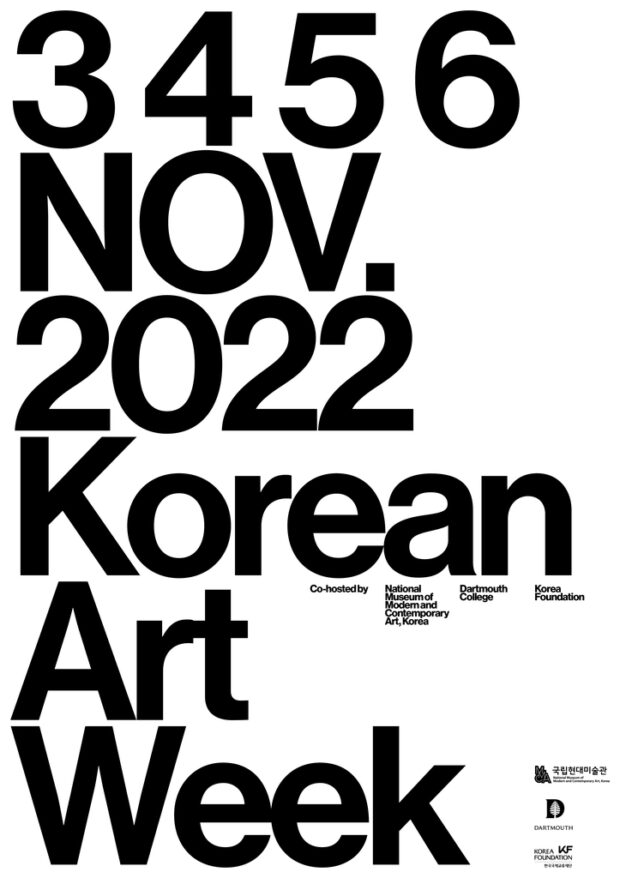


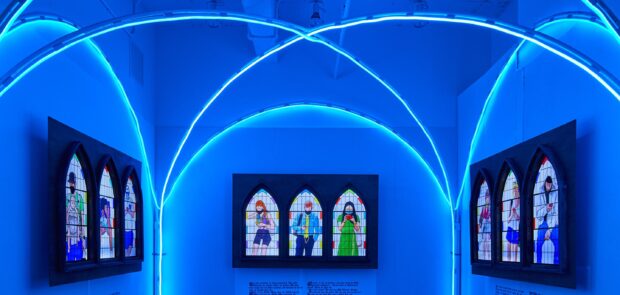

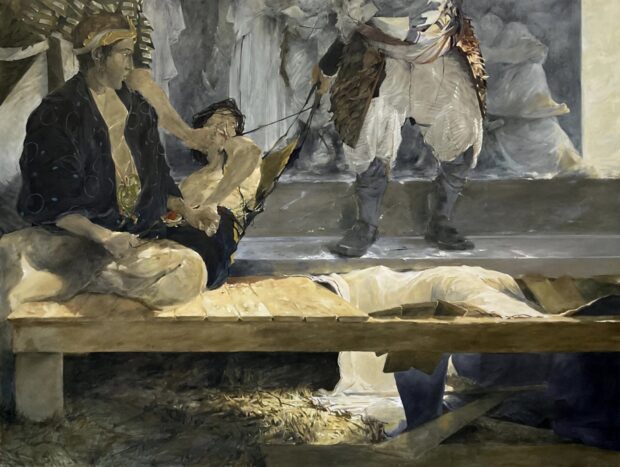
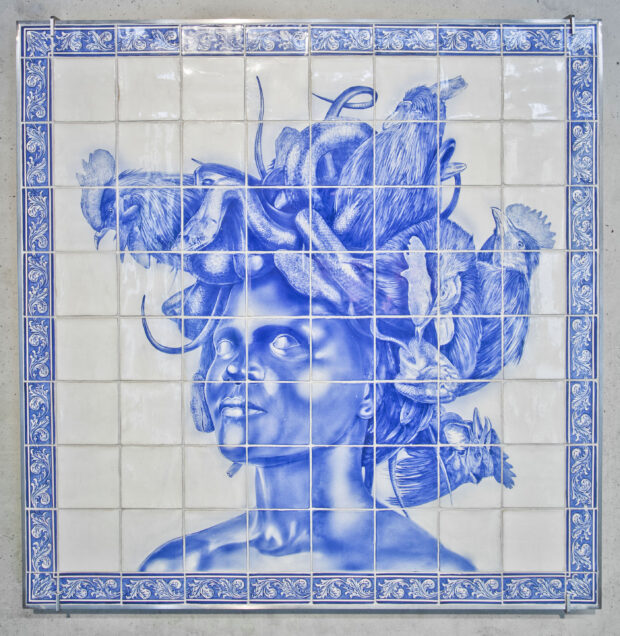


Be First to Comment